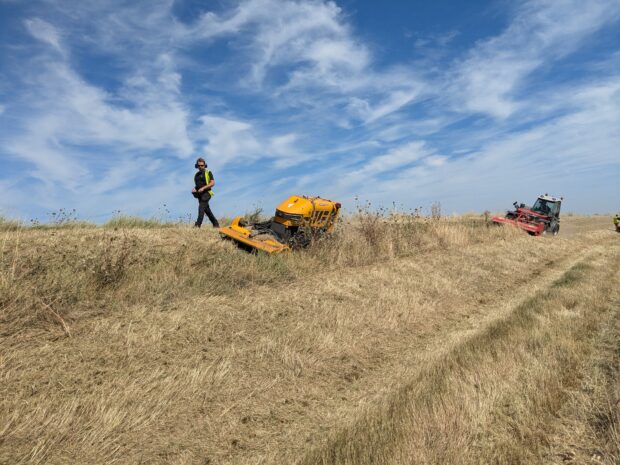
David Simpson, from an Essex Field Team explains how Environment Agency preparations for winter begins well ahead of the long nights drawing in.
As the summer was winding down, the Environment Agency was already undertaking important winter readiness actions. It may have seemed a bit early but thinking big and acting early are key parts of the Environment Agency’s ethos.
In Essex, cutting and clearing vegetation from our assets and strategically important watercourses, is an important part of this winter preparation. If left unchecked, this vegetation could restrict river channels during times of high flow.
This cutting regime is known as ‘the frequent maintenance program’, with locations cut on a one-, three- or five-year cycle. It is carried out using a mix of in-house field teams and contractors. The Environment Agency bids for public funding every year to carry out this maintenance and the decisions where to deploy the resource are based on flood modelling and historic data.
Vegetation clearance is delivered using various methods, dependent on the size and access to the channel. All our cutting regimes and blockage removal programmes adhere to the Water Framework Directive and other legislation which protect the wildlife in our rivers and streams.
Grass cutting on tidal defences
The Environment Agency maintains thousands of kilometres of naturalised flood embankments.
Field teams use specialist grass cutting equipment designed to operate on slopes. The embankments are cut before winter so defects can be identified. Shorter grass also improves asset performance, erosion resistance and ensures the asset operates to a high standard in the event of strong tides.
Weed boating
Specialist boats with cutter and raker heads are used in the wider channels. They cut the rivers through the towns and downstream, allowing water to get away quicker from the settlements. Whilst this equipment is on site, our teams take the opportunity to collect up items deposited in the river, such as shopping trollies, bikes and other dumped items.
Weed cutting with an excavator
This is used to cut main rivers that the EA maintains that are too narrow to fit weed boats into. An excavator with a specialist weed cutting bucket works parallel to the watercourse, depositing cut weed on the bank, allowing for any aquatic insects (invertebrates and eels) to safely return back to the river.
Water temperature and dissolved oxygen levels are measured before, during and after we cut weed, to ensure that we do not put wildlife at risk. If conditions deteriorate, we will stop work until it is safe to continue.
Hand brushing
The smaller watercourses that machines can’t access are cleared by hand. This is time sensitive work and ‘cut and clear’ gangs work their way through whilst the channels are still shallow just after summer, clearing blockages before the wet weather arrives.
With more frequent unprecedented weather events impacting our infrastructure and demand on it increasing, field teams are working towards becoming a resilient workforce of asset maintainers, committed to undertaking efficient, targeted and risk-based approach to flood and coastal erosion risk management.
Make sure you are signed up for flood warnings visit www.gov.uk/sign-up-for-flood-warnings for more information.

2 comments
Comment by Ruth Bamlett posted on
please find an email which I sent recently to a landowner. Farnham village is desperate to come to some kind of solution to a problem that has been going on for years. Unfortunately nobody wants to solve this problem and in the meantime the water course just is completely neglected and I am sure wildlife and the water course is suffering.
I am hoping that the environment agency may be able to help.
Dear Ruth
Peter Jarman has passed your email on to me. Sadly this is not a new problem. For instance, here is an extract from a letter I wrote to Essex County Council on 24 January 2016 on behalf of the then owner of the land on the west side of the Bourne:
“This watercourse has been the subject of recent correspondence including an email sent by Colin Street on 15 December 2014 to Shashiraj Marri and subsequently forwarded to the Clerk to the Farnham Parish Council. Mr Street is described as “Advisor (Watercourse Inspector), Asset Performance Team (East) Hertfordshire and North London Area” which would appear to indicate that he knows what he is talking about. He said:
The Farnham Bourne is designated by Defra as main river as shown on the map, the other watercourses are shown on the map as drainage ditches. We carry out maintenance for flood defence purposes where people and property are at risk of flooding from main rivers, other watercourses such as drainage ditches and ordinary watercourses are maintained by landowners or local authorities. The flooding to the road last Friday was coming surcharging manholes on one of the drainage ditches that discharges into the Farnham Bourne.
“On 1 September 2015, when there were more problems with the Bourne and the Clerk asked Mr Street what was being done to prevent them, he wrote:
I am sorry to hear that the flooding issues on the Farnham Road have not been resolved.
In regards to the Bourne being overgrown I’m afraid this is not something that I am able to help with. I believe I explained before that the Farnham Bourne is in a low consequence of failure system, this means that the risk of flooding to properties from the Bourne is low. Our funding for maintenance is being reduced again, we have to make sure that the funding we do get is spent where it provides the most flood defence benefit to people and properties.
“Two things are clear from these emails. First, the authority represented by Mr Street is responsible for the Bourne’s maintenance, not the landowner, and secondly that authority is not fulfilling its responsibility because it is seeking to economise. Instead it is trying to push that responsibility on to the landowner.”
So far as I know, that statement of the legal position has never been contested and remains valid. In the years since the letter was written, the authorities have carried out some substantial work on the drainage system all the way back to Wells Cottages but have failed to find a complete solution.
We do sympathise with those who use the lane but our responsibility stops with the vegetation growing on our bank of the river. As to the river itself, not only is it not our responsibility but, because it is classified as a “main river”, we are not allowed to interfere with it. Last year a farmer was prosecuted for doing just that. Nor would we be insured for any claim arising from anything we might have done to try to help.
Charles
Charles Humphreys
Hazel End Farm, CM23 1HG
Tel: 01279 812377
VAT No. 214641588
AWRS URN: XZAW00000101616
From: Ruth Bamlett <ruthbamlett@gmail.com>
Subject: Fwd: Flooding in Farnham CM231HT (Case Ref: KB50576)
Date: 9 January 2025 at 10:16:45 GMT
To: clerk@farnham-pc.gov.uk
Please could this email be forwarded to Petronella Humpheries:
Dear Petronella,
I am wondering whether you could help at all with what has become a very constant problem for the people who live in the village. Last week the bottom road was flooded and the weather was particularly bad and the flooding was expected. BUT we have now been left with a large piece of road which is flooded because the debris is blocking the drains and I don't think even the 'ditch' diggers from the village have the equipment to clear this because the water is so deep.
We really need help from you as the landowner to clear the ditches and maintain this stretch of road so that it is safe.
Thankyou in anticipation of your help in this matter.
Ruth Bamlett
Comment by Paul posted on
Hi if you have concerns about a main watercourse, risk of flooding, poor maintenance or impact on wildlife and habitat, you can discuss with and make a report to our Incident Communication Team on 0800 807060.
Regards
Paul - Customer Service Adviser